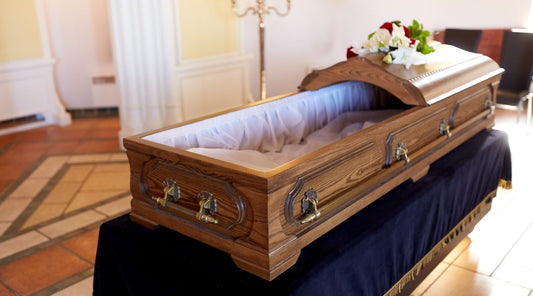
A Comprehensive Guide to Steel Funeral Caskets
Choosing the right casket for a loved one is a profound decision in the funeral planning process. Steel is favored among the various materials available for its resilience, versatility, and value. This detailed guide explores the facets of steel funeral caskets, including the manufacturing process, the variety of materials used, and an in-depth analysis of 18- versus 20-gauge steel options, helping you make an informed choice.
Steel caskets stand out for their robustness and affordability, appealing to families seeking a balance between cost and quality. These caskets are predominantly made from carbon steel or stainless steel and offer excellent durability against environmental factors. Carbon steel provides a sturdy and cost-effective option, while stainless steel offers enhanced resistance to corrosion, maintaining its integrity and appearance over time. Both materials allow for diverse customization in paint finishes and interior linings, ensuring that the deceased's personal preferences and individuality are honored.
The Manufacturing Process of Steel Caskets
The production of a steel casket is a meticulous process that begins with the selection of high-quality steel. The steel is precision-cut and formed into the casket's basic shape. Skilled artisans then employ techniques such as welding and brushing to construct a seamless and durable final product. Advanced machinery aids in creating detailed designs on the casket’s surface, while quality control measures ensure that each casket meets stringent standards for durability and aesthetics.
The manufacturing process of steel caskets is intricate and combines modern industrial techniques with meticulous craftsmanship. To better understand this process, it can be insightful to compare it with the manufacturing of auto body parts, which shares similar techniques but is applied in a vastly different context.
Precision Cutting, Forming, and Joining
Both steel caskets and auto body parts begin with the precision cutting of steel sheets. In casket manufacturing, the steel is typically cut into large, flat pieces that are then shaped to form the casket's base, lid, and sides. High-precision machinery, such as laser cutters or water jets, is employed to ensure that each cut is exact and that the dimensions are perfectly aligned with the design specifications.
The forming process in steel casket manufacturing involves bending the cut sheets into the desired shapes. This is typically achieved using press brakes, which carefully fold the steel without damaging the material. The caskets are then assembled using welding or riveting to join the pieces securely, ensuring a seamless appearance and structural integrity.
In contrast, auto body parts are formed using a variety of techniques depending on the part’s function and the material’s properties. Stamping is a common method for forming complex shapes like fenders and door panels. This process involves pressing the metal into dies to create detailed and precise shapes in a single operation. Welding, particularly spot welding, is extensively used to assemble the parts into larger sections of the vehicle's body.
Finishing Touches
Finishing processes in steel casket manufacturing involve several steps to enhance aesthetic appeal and durability. After assembly, the caskets are often coated with a primer to prevent corrosion, followed by a top coat of paint. High-quality finishes are crucial, as the appearance of the casket plays a significant role in its selection. The interiors are lined with fabrics like satin, velvet, or crepe, adding a final touch of elegance and comfort.
Auto body parts undergo similar finishing processes, where primer and paint are applied to protect against corrosion and to provide color. However, the painting process in auto manufacturing is typically more complex, involving multiple layers to achieve durability and gloss suited for exposure to environmental elements. Additionally, auto parts may receive treatments such as anti-rust coatings and sealants to enhance longevity and performance under various weather conditions.
Materials Used in Steel Caskets

The choice of material significantly affects a steel casket’s properties. Apart from carbon and stainless steel, manufacturers might incorporate alloy elements like chromium or nickel to boost the casket’s resistance to rust and decay. Finishes range from high-gloss to matte, offering choices that reflect the deceased’s style or the family’s wishes. Interior fabrics also vary, with options including velvet for a luxurious feel or satin for sleek simplicity.
18-Gauge vs 20-Gauge Steel
The steel gauge, indicating the material's thickness, is a critical factor in selecting a casket. 18-gauge steel, being thicker, offers superior durability and a heavier build, which can be reassuring to families looking for a robust memorial option. Conversely, 20-gauge steel, while thinner, provides a lighter and often more cost-effective choice without sacrificing quality or appearance. This section should detail the specific benefits of each type, such as the enhanced structural integrity of 18-gauge caskets or the affordability and wider availability of 20-gauge models.
The gauge significantly influences the casket's durability. Thicker gauges provide greater resistance to physical and environmental stresses, ensuring that the casket maintains its form and function over time. Aesthetically, thicker gauges allow for deeper, more intricate embossing and detailing, which can make the casket more visually appealing. These details are often important for families who wish to provide a dignified and honorable tribute to their loved ones.
Paint and Finish Options for Steel Funeral Caskets
One aspect to consider when choosing a steel funeral casket is the paint and finish. The finish adds to the casket's aesthetic appeal and offers a layer of protection to the steel beneath. Modern advancements have brought many options, including automotive-quality paint finishes known for their durability, gloss, and resistance to fading over time.
Automotive-quality paint finishes on steel funeral caskets are similar to those used on cars. This type of finish is renowned for its high gloss, depth of color, and superior durability. The application process involves multiple layers, including a base coat for color, a metallic layer for depth, and a clear coat for protection. This process ensures that the finish is resistant to scratches, chipping, and the effects of weathering, maintaining its beauty for years to come.
Gasketed vs. Non-Gasketed Caskets
A key feature in some steel caskets is the gasket—a rubber seal that enhances the casket’s integrity by protecting the interior from external elements like moisture and dirt. Gasketed caskets, generally available with 18-gauge steel, offer an added layer of protection, potentially extending the preservation of the casket’s appearance.
Gaskets are commonly found in premium casket offerings, often correlating with higher-end models such as those made from 18-gauge steel. The presence of a gasket is typically associated with enhanced construction quality and a focus on preserving the dignity of the deceased's final resting place. However, it's also crucial for consumers to understand that gaskets are an optional feature and not a legal requirement for burial caskets. Their inclusion increases the casket's cost, reflecting the additional materials and manufacturing processes involved. While Non-gasketed caskets are more economical, they can still provide a dignified solution.
Comparing Metal and Wood Caskets
While metal caskets offer durability and resistance to decay, wood caskets bring a different set of values, such as biodegradability and a natural aesthetic. Wood caskets, susceptible to decay, represent a choice for those looking for eco-friendly options or preferring the natural beauty of wood grains. This decision underscores the diverse considerations families must weigh, including environmental concerns and personal aesthetics.
What to Look for When Shopping for Steel Caskets
Selecting a steel casket involves multiple considerations. It’s crucial to balance factors such as the desired durability, aesthetic preferences, budget constraints, and personal values. Consumers should also consider the environmental impact of their choice, as steel caskets vary in their ecological footprint based on the materials and manufacturing processes used.
Steel caskets offer a durable, customizable, and aesthetically versatile choice for memorializing a loved one. By understanding the different aspects of steel caskets, including materials, gauge, and construction quality, families can make choices that truly honor their loved ones while accommodating personal preferences and budgetary constraints.
When choosing the right steel casket, it’s vital to weigh factors like durability, aesthetics, and cost to ensure that the selection respects the deceased's memory and provides a fitting tribute to their life. This comprehensive approach helps families navigate their options during a challenging time, making a decision that feels right in both heart and mind.


